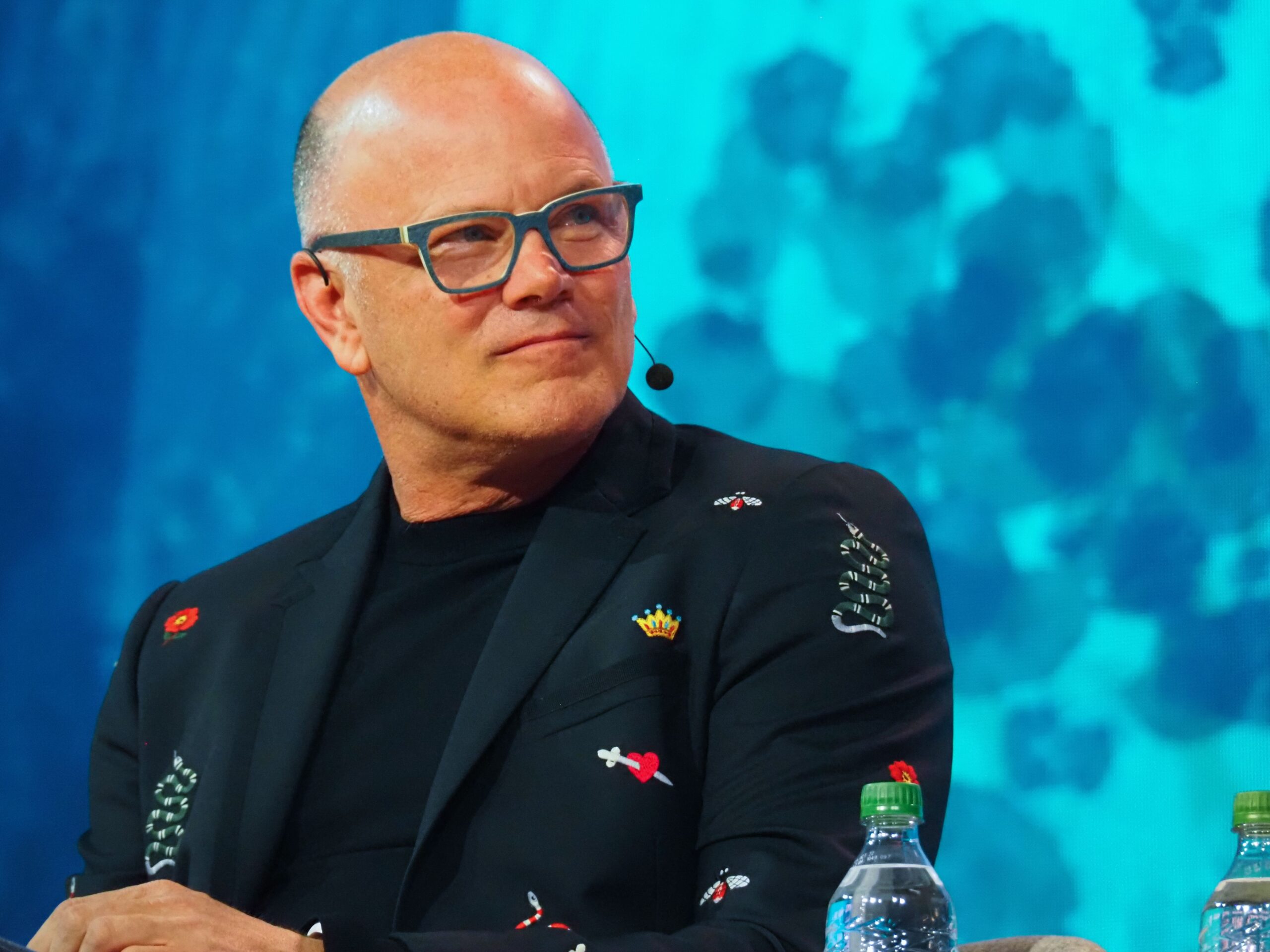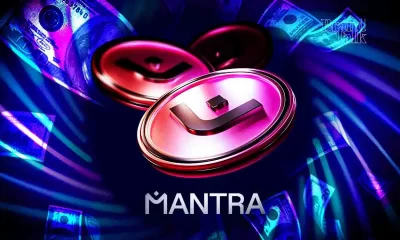Finance
Galaxy Digital (GLXY) Appoints Former Exec at Steve Cohen’s Point72 as CFO
Published
4 months agoon
By
admin

Michael Novogratz’s Galaxy Digital (GLXY) has hired former Point72 chief financial officer Anthony Paquette to serve in the same role at the crypto financial services firm.
He will replace Alex Ioffe, who will transition into a senior adviser role, the company said in a statement on Friday.
Paquette previously spent four years as the CFO at Steve Cohen’s hedge fund Point72, leading the firm’s global finance, treasury, and broker relations, among other things. Before that, he worked at SoFi, JP Morgan Chase and Bank of America.
“I am thrilled to join Galaxy, whose reputation as a world-class operator and investor in digital assets, digital infrastructure and other emerging technologies precedes it,” Paquette said in a press release. “I look forward to expanding upon Galaxy’s best-in-class finance team and helping further cement the firm as the preeminent industry leader.”
Galaxy Digital CEO Mike Novogratz thanked Ioffe for building a robust finance team and preparing the firm for a potential U.S. listing.
The Toronto-listed company has been trying to go public in the U.S. through a listing on Nasdaq for some time. However, it is still awaiting approval from the Securities and Exchange Commission (SEC) to move its headquarters from the Cayman Islands to Delaware, which it filed for approval in February 2023.
Source link
You may like


Crypto Strategist Sees Solana-Based Memecoin Surging Higher, Says One AI Altcoin Flashing Strong Chart


Mantra Team Responds As The OM Token Price Crashes Over 80% In 24 Hours


This Week in Crypto Games: Gaming Tokens Crash Out, Eve Frontier Opens Up


Commerce Secretary Lutnick walks back tariff relief on electronics


Gold ETF Inflows Hit Three-Year High as PAXG, XAUT Outperform Wider Crypto Market


Israel’s New Study Shows 51% Of Public Is Interested In Adopting CBDC (Digital Shekel) – Is That So?
artificial intelligence
Where Top VCs Think Crypto x AI Is Headed Next
Published
12 hours agoon
April 13, 2025By
admin

The proliferation of mainstream artificial intelligence (AI) tools in the last couple of years has stirred the crypto and blockchain industry to explore decentralized alternatives to Big Tech products.
The synergy between AI and blockchain is built on addressing the risk of centralized ownership and access to data that powers AI. The theory goes that decentralization can mitigate against the entire AI economy being powered by the data owned by a few tech behemoths like Alphabet (GOOG), Amazon (AMZN), Microsoft (MSFT), Alibaba (9988) and Tencent (0700).
It is unclear as yet whether or not this will prove to be a significant problem at all, much less whether the blockchain industry will be able to solve it. What is clear, however, is that crypto venture capitalists (VCs) are willing to spend millions of dollars finding out. Decentralized AI has thus far attracted $917 million in VC and private equity money, according to startup deal platform Tracxn.
The question remains whether the trend of investing in blockchain-based AI is still built on hype or has now transcended to being the real deal.
Blockchain investment company Theta Capital described AI x crypto as “the inevitable backbone of AI,” in a recent “Satellite View” report, which explored insights and outlooks from the sector’s prominent investors.
AI agents
“No trend stands out more than the intersection of AI and crypto,” the report said, using the examples of AI agents trading on blockchains and even launching tokens.
This may appear to be a more sophisticated form of speculation for degens, but Theta argues it’s a route to tackling some of AI’s problems that only crypto can solve.
“Crypto wallets enable the participation of autonomous agents in financial markets,” according to the report. “Decentralized token networks are bootstrapping the supply side of key AI infrastructure for compute, data and energy.”
The report’s conclusion is far from being hype and speculation; AI x crypto is “the new meta.” Meta is short for “metagame,” a term borrowed from gaming referring to the dominant way of playing with regard to characters, strategies or moves based on the competitive landscape.
Decentralized AI
Alex Pack, managing partner of blockchain venture capital firm Hack VC, described Web3 AI as “the biggest source of alpha in investing today,” in the “Satellite View” report.
Hack VC has dedicated 41% of its latest fund to Web3 AI, according to the report, in which it sees the main challenge as building a decentralized alternative to the AI economy.
“AI’s rapid evolution is creating massive efficiencies, but also increasing centralization,” Pack said.
“The intersection of crypto and AI is by far the biggest investment opportunity in the space, offering an open, decentralized alternative.”
One of Hack VC’s most prominent portfolio companies is Grass, which encourages users to participate in AI networks by offering up their unused internet bandwidth in return for tokens.
This is designed as an alternative to large firms installing software code into apps in order to scrape their users’ data.
“Users unwittingly donate their bandwidth without compensation,” Grass founder Andrej Radonjic said in Theta’s report.
“Grass provides an alternative [by] forming a massive opt-in, peer-to-peer network able to produce high-quality data at the scale of Google and Microsoft.”
The dreaded AI “takeover”
Decentralized AI presents risks for investors, Theta concedes. It could lead to the proliferation of all the least desirable facets of the internet as it already exists: putrid online discourse, spam emails or vapid social media content in the form of blogs, videos or memes. In the crypto world, an example of this may be the creation of meme tokens. The questionable endorsements, the wash trading and the pump and dumps can all be handled by AI engines even more efficiently than humans.
Some VCs see blockchain as the basis for mitigation. Olaf Carlson-Wee, CEO and founder of Polychain, provided the examples of proof-of-humanity mechanisms to verify that users are human and disincentivizing spam through micropayments or spam.
“If sending an email costs $0.01, it would destroy the economics of spam while remaining affordable for average users,” he said in the report.
With blockchain possibly providing some of these safeguards, Carlson-Wee believes AI will underpin digital and financial systems, as they could outperform humans in markets. This reality, he claims, would be gladly accepted, as opposed to dreaded as some sort of bleak dystopia.
“Over time, AI systems will evolve into long-term capital allocators, predicting trends and opportunities years into the future, [which] humans will entrust their funds to, because of the superior ability to make data-driven decisions,” Carlson-Wee said.
“The AI takeover won’t be a war we lose – it will be a suggestion we agree to,” he concluded.
Source link
Bitcoin mining
Luxor’s Aaron Foster on Bitcoin Mining’s Growing Sophistication
Published
1 day agoon
April 12, 2025By
admin

Luxor Technology wants to make bitcoin mining easier. That’s why the firm has rolled out a panoply of products (mining pools, hashrate derivatives, data analytics, ASIC brokerage) to help bitcoin miners, large and small, develop their operations.
Aaron Forster, the company’s director of business development, joined in October 2021, and has seen the team grow from roughly 15 to 85 people in the span of three and a half years.
Forster worked a decade in the Canadian energy sector before coming to bitcoin mining, which is one of the reasons why he’ll be speaking about the future of mining in Canada and the U.S. at the BTC & Mining Summit at Consensus this year.
Follow full coverage of Consensus 2025 in Toronto May 14-16.
In the leadup to the event, Forster shared with CoinDesk his thoughts on bitcoin miners turning to artificial intelligence, the growing sophistication of the mining industry, and how Luxor’s products enable miners to hedge various forms of risk.
This interview has been condensed and edited for clarity.
CoinDesk: Mining pools allow miners to combine their computational resources to have higher chances of receiving bitcoin block rewards. Can you explain to us how Luxor’s mining pools work?
Aaron Forster: Mining pools are basically aggregators that reduce the variance of solo mining. When you look at solo mining, it’s very lottery-esque, meaning that you could be plugging your machines in and you might hit block rewards tomorrow — or you might hit it 100 years from now. But you’re still paying for energy during that time. At a small scale, it’s not a big deal, as you scale that up and create a business around it.
The most common kind of mining pool is PPLNS, which means Pay-Per-Last-N-Shares. Basically, that means the miner does not get paid unless that mining pool hits the block. That’s also due to luck variance, so it’s no different from that solo miner’s situation. However, that creates revenue volatility for those large industrial miners.
So we’re seeing the emergence of what we call Full-Pay-Per-Share, or FPPS, and that’s Luxor is operating for our bitcoin pool. With FPPS, regardless of whether we find a block or not, we’re still paying our miners their revenue based on the number of shares they’ve submitted to the pool. That gives revenue certainty to miners, assuming hashprice stays the same. We’ve effectively become an insurance provider.
The problem is that you need a very deep and strong balance sheet to support that model, because while we’ve reduced the variance for miners, that risk is now put on us. So we need to plan for that. But it can be calculated over a long enough period of time. We have different partners in that regard, so that we don’t bear the full risk from our balance sheet.
Tell me about your ASIC brokerage business.
We’ve become one of the leading hardware suppliers on the secondary market. Primarily within North America, but we’ve shipped to 35+ countries. We deal with everybody from public companies to private companies, institutions to retail.
We’re primarily a broker, meaning we match buyer and seller, mostly on the secondary market. Sometimes we do interact with ASIC manufacturers, and in certain cases we do take principal positions, meaning we use money from our balance sheet to purchase ASICs and then resell them on the secondary market. But the majority of our volume comes from matching buyers and sellers.
Luxor also launched the first hashrate futures contracts.
We’re trying to push the Bitcoin mining space forward. We’re a hashrate marketplace, depending on how you look at our mining pools, and we wanted to take a big leap and take hashrate to the TradFi world.
We wanted to create a tool that allows investors to take a position on hashprice without effectively owning mining equipment. Hashprice is, you know, the hourly or daily revenue that miners get, and that fluctuates a lot. For some people it’s about hedging, for others it’s speculation. We’re creating a tool for miners to sell their hashrate forward and use it as a basic collateral or a way to finance growth.
We said, ‘Let’s allow miners to basically sell forward hashrate, receive bitcoin upfront, and then they can take that and do whatever they need to do with it, whether it’s purchase ASICs or expand their mining operations.’ It’s basically the collateralization of hashrate. So they’re obligated to send us X amount of hashrate per month for the length of the contract. Before that, they’ll receive a certain amount of bitcoin upfront.
There’s a market imbalance between buyers and sellers. We have a lot of buyers, meaning people and institutions wanting to earn yield on their bitcoin. What you’re lending your bitcoin at is effectively your interest rate. However, you could also look at it like you’re purchasing that hashrate at a discount. That’s important for institutions or folks that don’t want physical exposure to bitcoin mining, but want exposure to hash price or hashrate. They can do that synthetically through purchasing bitcoin and putting it into our market, effectively lending that out, earning a yield, and purchasing that hashrate at a discount.
What do you find most exciting about bitcoin mining at the moment?
The acceptance and natural progression of our industry into other markets. We can’t ignore the AI HPC transition. Instead of building these mega mines that are just massive buildings with power-dense bitcoin mining operations, you’re starting to see large miners turning into power infrastructure providers for artificial intelligence.
Using bitcoin mining as a stepping stone to a larger, more capital intensive industry like AI is exciting to me, because it kind of gives us a bit more acceptance, because we’re coming at it from a completely different angle. I think the biggest example is the Core Scientific / CoreWeave deal structure, how they’ve kind of merged those two businesses together. They’re complimentary to each other. And that’s really exciting.
When you look at our own product roadmap, we have no choice but to follow a similar roadmap to bitcoin miners. A lot of the products that we built for the mining industry are analogous to what is needed at a different level for AI. Mind you, it’s a lot simpler in our industry than in AI. We’re our first step into the HPC space, and it’s still very early days there.
Source link
a16z
Stablecoins Are ‘WhatsApp Moment’ for Money Transfers, a16z Says
Published
4 days agoon
April 10, 2025By
admin

Remember the old days when calling or sending a message via text outside the country cost money? With the help of modern messaging apps like WhatsApp, paying for cross-border calls and texts is now obsolete.
For money transfers, stablecoins might do just that: democratize the payments industry by eliminating historical gatekeepers, says venture firm Andreessen Horowitz (a16z).
“Just as WhatsApp disrupted costly international phone calls, blockchain payments and stablecoins are transforming global money transfers,” the firm said in a blog post on Wednesday.
The current global payment infrastructure is a complex web involving points of sale, payment processors, acquiring banks, issuing banks, correspondent banks, foreign exchanges, and card networks.
Read more: What Is a Stablecoin?
To make matters more difficult, each of these intermediaries charges fees and introduces delays, making international transactions cumbersome. For instance, a16z says remittance fees can reach up to 10% — just like cross-border calls or text used to be restrictive before instant messaging apps came into play.
Enter blockchain and stablecoins — cryptocurrencies pegged to assets like the U.S. dollar.
“Stablecoins offer a clean-slate alternative. Instead of stitching together clunky, costly, and outdated systems, stablecoins flow seamlessly on top of global blockchains,” the blog post said.
“Already, stablecoins are slashing the cost of remittances: Sending $200 from the U.S. to Columbia using traditional methods will cost you $12.13; with stablecoins, it costs $0.01.”
And, it’s not just remittances where stablecoins are eliminating inefficiencies; this could help boost B2B payments on a massive scale, too. A16z uses business transactions from Mexico to Vietnam as an example, which take three to seven days to process and cost anywhere between $14-to-$150 per $1000 transacted. These pass through as many as five intermediaries along the way, each of which takes a cut.
The adoption of stablecoin could make such transactions nearly free and instant, it says.
Some corporations have taken notice, and Elon Musk’s SpaceX is already using stablecoins to manage their corporate treasuries to shield itself from FX volatility.
So, it shouldn’t surprise anyone to see that the total market cap of stablecoins has passed $200 billion or that the annualized transaction value of stablecoins in 2024 hit $15.6 trillion — roughly 119% and 200% that of Visa and Mastercard, respectively.
However, the rise of stablecoins isn’t without challenges.
Regulatory bodies have scrutinized their use, making it “incredibly difficult” to bridge traditional finance to stablecoins, said a16z. The landscape is now finally evolving, as policymakers are now actively shaping rules to recognize and regulate stablecoins in the U.S. “A forthcoming bill clarifying this regulation could pave the way for even broader adoption and integration into the global financial system,” the blog said.
With the rapidly changing landscape for finance and crypto becoming more mainstream, stablecoins could become the transformative force that revolutionizes the future of money.
“Just as WhatsApp disrupted costly international phone calls, blockchain payments and stablecoins are transforming global money transfers,” added a16z.
Read more: U.S. House Committee Advances Stablecoin Bill, While Dems Warn of Trump Conflicts
Source link

Crypto Strategist Sees Solana-Based Memecoin Surging Higher, Says One AI Altcoin Flashing Strong Chart

Mantra Team Responds As The OM Token Price Crashes Over 80% In 24 Hours

This Week in Crypto Games: Gaming Tokens Crash Out, Eve Frontier Opens Up

Commerce Secretary Lutnick walks back tariff relief on electronics

Gold ETF Inflows Hit Three-Year High as PAXG, XAUT Outperform Wider Crypto Market

Israel’s New Study Shows 51% Of Public Is Interested In Adopting CBDC (Digital Shekel) – Is That So?

Solana Price Eyes Breakout Toward $143 As Inverse Head & Shoulders Pattern Takes Shape On 4-hour Chart

Crypto malware silently steals ETH, XRP, SOL from wallets

Binance Executives Met With US Government Officials To Discuss Easing of Regulatory Supervision: Report

Michael Saylor Hints At Another MicroStrategy Bitcoin Purchase, BTC Price To Rally?

From the Crypto Trenches to the Hill: Why Solana Is Making a Big Push in Washington

Bitcoin price tags $86K as Trump tariff relief boosts breakout odds

Where Top VCs Think Crypto x AI Is Headed Next

India’s Leading Bitcoin And Crypto Exchange Unocoin Integrates Lightning

Solana Triggers Long Thesis After Pushing Above $125 – Start Of A Bigger Rally?

Arthur Hayes, Murad’s Prediction For Meme Coins, AI & DeFi Coins For 2025

Expert Sees Bitcoin Dipping To $50K While Bullish Signs Persist

Aptos Leverages Chainlink To Enhance Scalability and Data Access

Bitcoin Could Rally to $80,000 on the Eve of US Elections

Crypto’s Big Trump Gamble Is Risky

Sonic Now ‘Golden Standard’ of Layer-2s After Scaling Transactions to 16,000+ per Second, Says Andre Cronje

Institutional Investors Go All In on Crypto as 57% Plan to Boost Allocations as Bull Run Heats Up, Sygnum Survey Reveals

Ripple-SEC Case Ends, But These 3 Rivals Could Jump 500x

Has The Bitcoin Price Already Peaked?

A16z-backed Espresso announces mainnet launch of core product

The Future of Bitcoin: Scaling, Institutional Adoption, and Strategic Reserves with Rich Rines

3 Voting Polls Show Why Ripple’s XRP Price Could Hit $10 Soon

Xmas Altcoin Rally Insights by BNM Agent I

Blockchain groups challenge new broker reporting rule

I’m Grateful for Trump’s Embrace of Bitcoin
Trending

 24/7 Cryptocurrency News5 months ago
24/7 Cryptocurrency News5 months agoArthur Hayes, Murad’s Prediction For Meme Coins, AI & DeFi Coins For 2025

 Bitcoin3 months ago
Bitcoin3 months agoExpert Sees Bitcoin Dipping To $50K While Bullish Signs Persist

 24/7 Cryptocurrency News3 months ago
24/7 Cryptocurrency News3 months agoAptos Leverages Chainlink To Enhance Scalability and Data Access

 Bitcoin5 months ago
Bitcoin5 months agoBitcoin Could Rally to $80,000 on the Eve of US Elections

 Opinion5 months ago
Opinion5 months agoCrypto’s Big Trump Gamble Is Risky

 Altcoins2 months ago
Altcoins2 months agoSonic Now ‘Golden Standard’ of Layer-2s After Scaling Transactions to 16,000+ per Second, Says Andre Cronje

 Bitcoin5 months ago
Bitcoin5 months agoInstitutional Investors Go All In on Crypto as 57% Plan to Boost Allocations as Bull Run Heats Up, Sygnum Survey Reveals

 Price analysis5 months ago
Price analysis5 months agoRipple-SEC Case Ends, But These 3 Rivals Could Jump 500x


